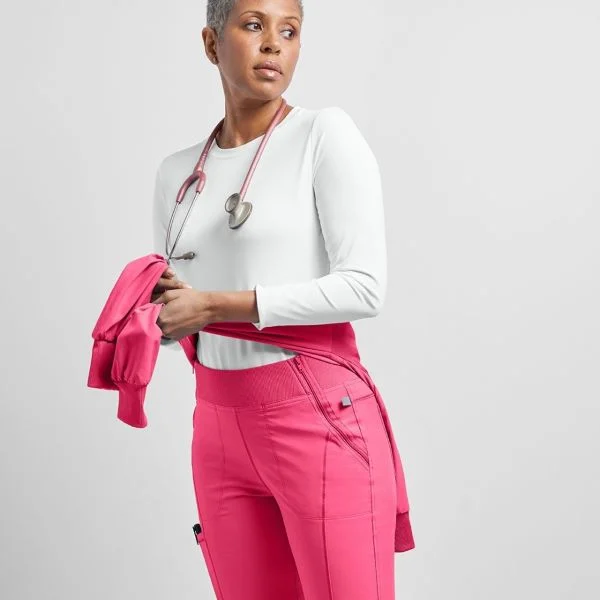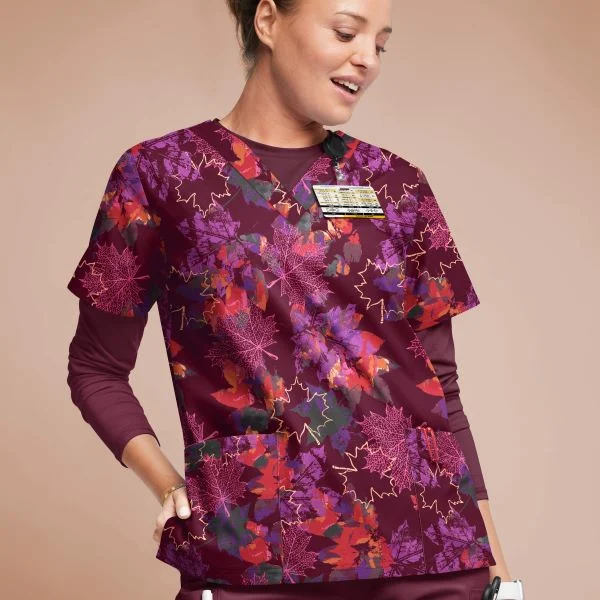What to Wear Under Scrubs and Medical Uniforms
October 8, 2024
By: Sumitra Pandita
When you're a healthcare professional putting together your daily wardrobe, picking the right pieces is more than just a matter of personal comfort; it's about meeting the demands of your work environment while still maintaining professionalism and hygiene. While some medical professionals might be restricted to wearing standard scrubs, others have the flexibility to wear additional layers or accessories.
One of the most common questions our team receives is, "What do you wear under scrubs?" We'll discuss the many factors that influence what you should wear under scrubs and how you can balance comfort, compliance, and functionality in your everyday workwear.
Do You Wear Clothes Under Scrubs?
If you're working in healthcare, what you can wear under your scrubs really depends on where you work. For example, in operating rooms, the rules are usually strict, and you might not be allowed to wear extra layers to keep everything sterile. But if you work somewhere more relaxed, like a clinic or a general hospital floor, you might be able to wear an undershirt or something else for warmth and comfort. So, it's crucial to know your workplace’s rules to avoid breaking any.
Because healthcare professionals have different needs, the industry has developed "underscrubs," which are undergarments made specifically to be worn under scrubs. They come in different styles like t-shirts, tank tops, and long sleeves, and they’re made from materials that keep you comfortable, such as moisture-wicking fabrics that help keep you dry and prevent overheating.
A lot of healthcare workers choose underscrubs not just for warmth and sweat management, but also because they can add a bit of style. They provide a polished look under lighter scrubs. Whether you're seeking functionality or want to add a touch of personal flair, underscrubs are a popular option for combining comfort and practicality with the standard scrub uniform.

What to Wear Under Scrubs: The Importance of Choosing the Right Undergarments
Selecting the best undergarments for scrubs is essential for maintaining hygiene, ensuring comfort throughout your shift, and adhering to workplace standards. The right choice can also impact your professional appearance and how effectively you can perform your job.
Here are some key considerations to help you make an informed decision based on workplace requirements, professional roles, and personal comfort preferences.
Workplace Requirements
In environments like operating rooms, where sterility is paramount, policies often restrict what can be worn under scrubs. These rules are designed to reduce the risk of contamination, which could compromise patient safety. For instance, staff may be prohibited from wearing any form of undergarment that sheds fibers or retains contaminants. In such settings, choosing the right undergarment becomes a matter of compliance with health and safety regulations rather than personal choice.
There are also certain workplaces where undergarments should not be visible to maintain a professional, cohesive appearance among all staff. If your employer has a rule like this in place, you'll want to opt for "no-show" undergarments. Depending on your scrub color, this could mean selecting light or flesh-toned undergarments or finding pieces that will comfortably fit under your scrub tops and pants without showing.
However, if you don't work in an environment with a strict dress code, you may have more flexibility with your wardrobe. If your employer allows, you might even choose printed or colorful undergarments, such as long-sleeved underscrubs, as a way to add a fun pop of personality to your outfit.
Professional Role
For those in physically demanding roles, such as emergency room staff or paramedics, choosing undergarments that provide additional support and feature moisture-wicking properties is beneficial. For example, compression shirts can be worn under scrubs to help reduce muscle fatigue and improve circulation, which is vital during long shifts that require a lot of movement. Similarly, moisture-wicking fabrics help manage sweat, keeping you dry and comfortable, which is crucial for maintaining focus and efficiency during critical tasks.
Medical professionals who spend significant time interacting with patients, such as nurses or general practitioners, may consider choosing undergarments that ensure modesty in a full range of motion. For example, high-coverage undershirts or underwear can be a good option to prevent any accidental exposure while bending over or reaching up.
Personal Comfort and Preferences
Of course, ensuring your comfort and confidence is a crucial factor in choosing your day-to-day wardrobe. After considering the rules and expectations of your workplace and role, make sure you take your personal preferences into account.

Choose Uniform Advantage for Scrubs and Medical Uniforms
Explore our extensive selection of scrubs and nursing uniforms today. Find out why so many healthcare professionals trust Uniform Advantage for their workwear needs. Our collection has something to enhance everyone’s wardrobe. Our commitment to quality, as well as our diverse selection of scrubs and accessories, makes Uniform Advantage your go-to source for upgrading your work wardrobe.
